This is an Olympus Trip 35, a 35mm scale focus camera made by Olympus Optical Co., Ltd. between the years 1967 and 1984. The Trip was an extremely popular compact camera and is credited as one of the first truly successful point and shoot cameras, ushering in a new age of simple cameras to those who otherwise would never have bought a rangefinder or SLR camera. The Trip requires no batteries and uses a selenium cell exposure meter for programmed auto exposure, but also allows for the option of manually selected f/stops. The Trip came with an accurate metering system, a reliable shutter, and a quality lens which meant that it was both dependable and delivered excellent results for the millions of people using them. Many can still be found in good working condition today, making them an ideal point and shoot for film shooters looking for an easy to use, but high quality, vintage shooting experience.
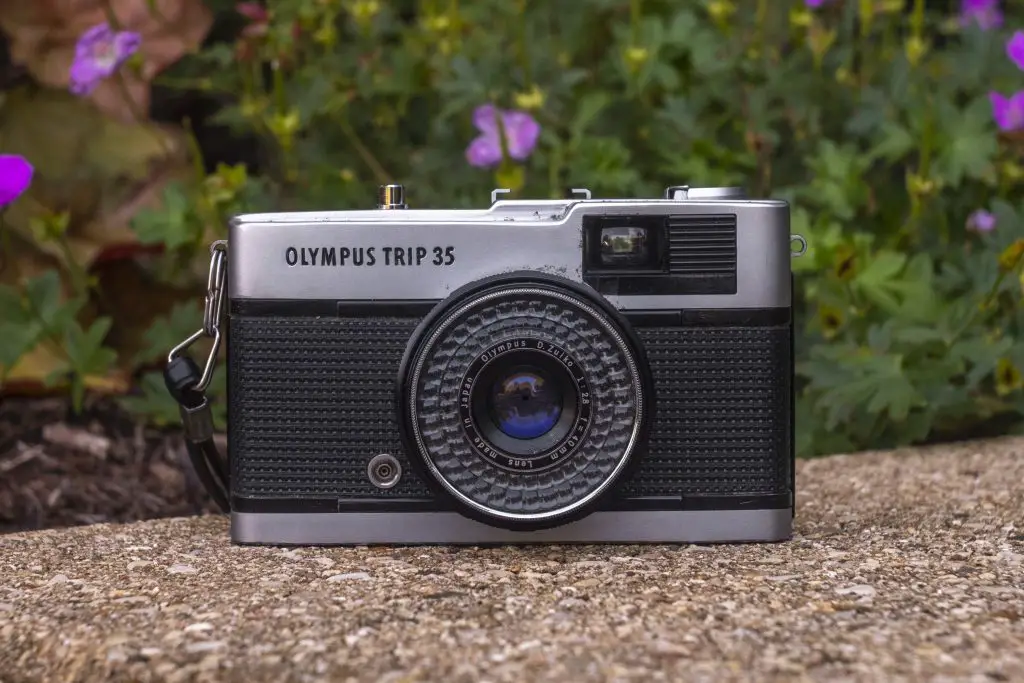 Film Type: 135 (35mm)
Film Type: 135 (35mm)
Lens: 40mm f/2.8 Olympus D.Zuiko coated 4-elements
Focus: 1 meter to Infinity with Click Stops for Closeup, Portrait, Group, and Scenery
Viewfinder: Scale Focus with 40mm Projected Frame Lines and Focus Distance Judas Window
Shutter: Twin Blade Between the Lens
Speeds: 1/40 and 1/200 seconds
Exposure Meter: Coupled Selenium Cell w/ Programmed AE
Battery: None
Flash Mount: Hot Shoe and M and X Flash Sync, 1/40 X-sync
Weight: 410 grams
Manual: https://www.cameramanuals.org/olympus_pdf/olympus_trip_35.pdf
How these ratings work |
The Olympus Trip 35 is a compact and simple, yet very capable camera that was in production for nearly a decade and a half. It is a very well known model that is reviewed positively for good reason. Finding them cheaply is very easy and their simple design means they’re usually found in good working condition. With a simple, but usable auto exposure system and an excellent 4-element lens, it is very easy to get very good results from the camera and with it’s small size, means you can carry it with you anywhere you go. Highly recommended! | ||||||
| Images | Handling | Features | Viewfinder | Feel & Beauty | History | Age | |
| 2 | 2 | 1 | 1 | 2 | 2 | 20% | |
| Bonus | +1 for perfect balance of size, easy of use, and quality, one of the best compact cameras ever made | ||||||
| Final Score | 13.0 | ||||||
When you look at the progression of 20th century camera development, you can see some themes surrounding the style and features of cameras that were released in a particular period. Folding and box cameras dominated the earliest parts of the 20th century, Leica and other 35mm “miniature” cameras were all the rage in the 30s and 40s. By the 50s, the Single Lens Reflex began to be the preferred style of camera over the rangefinder, and at the start of the 60s, “electric eye” cameras opened up doors with auto exposure to people who otherwise wouldn’t have been able to (or didn’t want to) shoot high quality and properly exposed images.
It seems that by the end of the 1960s and going into the 70s, the industry was getting the idea that people wanted more compact and easy to use cameras, but without too many sacrifices in quality. Auto Exposure not only eliminated a lot of the guesswork that would have stumped novice photographers, but also meant that the manual controls that are needed to set things like shutter speed and f/stops could be eliminated from the design, making them simpler to produce and cheaper to sell. The prevalence of electronics, both in shutters, metering systems, and viewfinder displays also helped decrease the size of cameras compared to fully mechanical ones a decade earlier.
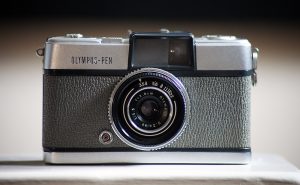
Of all the major players at the time, Olympus seemed to be the one company who did the most to differentiate themselves in the compact camera market. The half frame Olympus Pen model made it’s debut in 1959 before anyone else was making a serious effort in the compact camera segment. Each of Olympus’s subsequent full frame cameras were smaller than those released by their competitors, and although it wasn’t out yet, the upcoming OM-series SLR would offer a fully featured semi-professional level camera system in the smallest package possible.
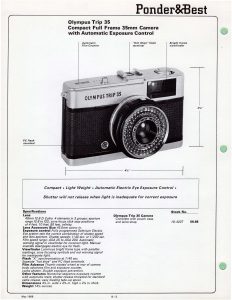
In 1968, a new model called the Olympus Trip 35 would make it’s debut to relatively little fanfare. This new camera broke very little new ground, it didn’t have the credentials of the Pen’s designer Yoshihisa Maitani, and none of it’s specifications would have excited semi or professional photographers. The name “Trip” was chosen to suggest the camera’s intended purpose as a vacation camera for people who wanted a capable, yet compact and simple camera.
Originally retailing in 1968 for $59.95, when adjusted for inflation this compares to about $450 today which is right in the realm of what a capable, yet not out of reach camera would sell for today. The Trip had a quality 4-element D.Zuiko lens, fully automatic programmed auto exposure via a selenium meter, and an easy to use focusing system with click stops for Portrait, Group, and Scenery. The camera was only slightly larger than the very popular Pen series yet exposed full sized 24mm x 36mm shots on regular 35mm film.
Throughout it’s decade and a half of production, the camera only saw very minor changes. The two most obvious were the switch from a chrome to a black plastic shutter release button and an expansion of the ASA film speeds from 200 to 400.
In my research for this article, I found very little information about the Trip around the time of it’s release and into the early 1970s. The most prevalent form of advertising was a series of commercials that aired in the UK featuring famous photographer David Bailey and his Trip.
Check out the following commercial featuring Bailey and Monty Python alum, Eric Idle.
It doesn’t seem as though the camera caught on until a few years after it’s release, but once it did, it remained a very popular model being sold until the early to mid 1980s. Many sites on the Internet today suggest that up to 10 million Trip 35s were sold, but based on serial number research, the actual number is probably closer to half that. But even with 5 million units sold, the Olympus Trip 35 remains one of the most successful single models of any camera ever made.
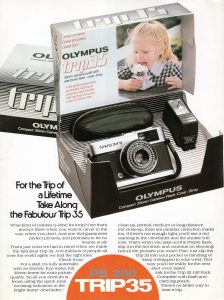
By the time the Trip 35 went out of production in 1984, there were already a huge number of more advanced cameras with more features, yet the appeal of a mechanical camera that worked without a battery and could still deliver quality results is why it stayed around for so long.
Olympus recognized the success of the Trip name and would reuse it in a series of simple auto focus cameras that were in production from 1984 to 2000, but none with the long lived popularity as the original Trip 35.
Today, the Olympus Trip 35 remains a very popular model for collectors and film enthusiasts alike. A combination of a plentiful supply of them that can be found cheaply, good reliability, and an easy to use design that produces excellent results means that almost everyone who uses one, still has favorable things to say about them. This is a model that is highly recommended by many, including me, and one that definitely deserves a place in your collection.
Year of Production
The Olympus Trip 35 was in production for about a decade and a half, and a common question among collectors is when was my camera made? There are a few articles online suggesting that the earliest models have 6 digit serial numbers and the first 7 digit serial numbers appeared in 1971 – 72, but the Olympus Trip 35 Flickr group has a post that suggests the month and year of manufacture can be revealed by a date code stamped on the underside of the film pressure plate.
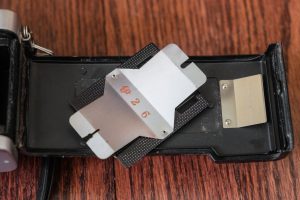
The pressure plate is easy to remove as it simply needs to be pulled off on one side. Do it slowly so as not to bend the clips, but I was able to get mine off without any damage to it. Sure enough, on the back of mine, I saw the number 26 which suggests mine was made in June 1972. I’ve copied the relevant information from that Flickr group here, and take no credit for this information.
- 1st Japanese character or letter (in later models) signifying the assembly plant.
- 2nd number representing the last digit of the year of assembly (e.g. 5 = 1975, 0 = 1980).
- 3rd number or letter representing the month of assembly, 1-9 for Jan-Sep, X, Y, Z for Oct-Dec.
The Trip 35 was manufactured between 1967 and 1984, so if you are unsure if you have a 1968 or 1978 model, the chrome shutter button is the earlier and the black the later.
Further reading through the discussion in this thread, it appears that later Trips either don’t have this number stamped anywhere, or the numbers that are there don’t make any sense so it’s possible that the later cameras either used a different system, or none at all, but this should at least allow a good number of Trips to be dated.
My Thoughts
 There is no shortage of reviews for the Olympus Trip 35 on the Internet. A quick Google search returns at least a dozen well written reviews on just the first two pages. Each of those reviews range from good to absolutely glowing as they unanimously seem to praise the Trip 35 as one of the most convenient travel cameras ever made.
There is no shortage of reviews for the Olympus Trip 35 on the Internet. A quick Google search returns at least a dozen well written reviews on just the first two pages. Each of those reviews range from good to absolutely glowing as they unanimously seem to praise the Trip 35 as one of the most convenient travel cameras ever made.
How good could it be? This is a simple compact camera from the “electric eye” era with a large selenium meter and a limited number of shutter speeds, after all. There were tons of cameras like this made over the years, so despite the overwhelming evidence that the Trip 35 was something special I had to find out for myself.
For starters, the Trip is small, but not too small. This was a camera that was designed to be packed into luggage and taken on vacation, so portability was factored into it’s size. Of course Olympus already had their well known half-frame Pen series, and the Trip 35 in someways looks like a full size Pen. At a weight of 390 grams, the camera is light enough to not be noticeable when hanging from a wrist strap, but isn’t so lightweight as to feel cheap.
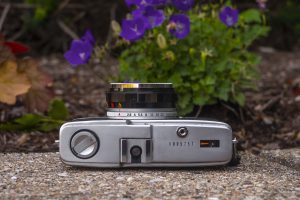
The overall design of the camera has a very minimalist Japanese look to it. By that I mean, no unnecessary bumps, curves, or protrusions. The top plate is very straightforward featuring a rewind knob with fold out handle, the flash hot shoe, cable threaded shutter release, and automatic resetting exposure counter window. The shutter release on this one is chrome as were all the earlier Trips. At some point in the late 70s or early 80s, the shutter release was changed to a black plastic type, but otherwise looked the same.

Flip the camera over and the bottom has the rewind release button and a centrally located 1/4″ tripod socket. While I always appreciate the inclusion of a well thought out tripod socket, the lack of a Bulb or any shutter speed slower than 1/40 likely suggests that not too many Trips ever saw use on a tripod.
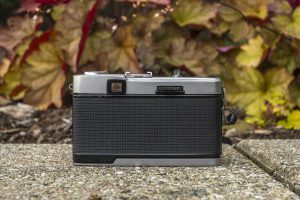
The back of the camera continues with the same squared pattern vinyl body covering from the front and features a rectangular viewfinder window and to the right, the film advance wheel.
This style of rear film advance wheel was a hallmark of most of Olympus’s compact cameras. It first appeared on the original Olympus Pen in 1959 as a way to make the camera as inexpensive as possible and continued with the Trip and the later XA-series of cameras.
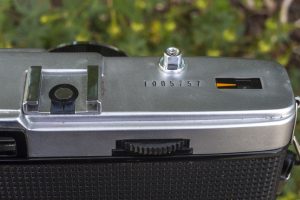
Although a cost cutting measure, in reality it works quite well, as two quick left to right swipes of your right thumb across the wheel is enough to advance the film one full exposure while simultaneously cocking the shutter. I can’t honestly say that a film advance lever would have been much faster.

Loading film into the Trip is an uneventful affair. There is a small release on the bottom of the camera’s left side which unlocks the door. Film loads from left to right onto a multi-slotted fixed take up spool.
Despite it’s economy pricing, the film compartment is as good as cameras costing quite a bit more with it’s over sized and dimpled film pressure plate which helps maintain film flatness while decreasing resistance, and even featuring a metal spring on the door to help keep the cassette stable while shooting. In the previous image to the left, you can see this camera’s degraded light seals which like many cameras of the era, needed to be replaced before I could shoot it.
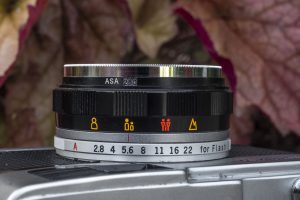
Although lacking a rangefinder or any other kind of optical focus aide, the Trip 35 has a simplified focusing system that uses 4 click stops for various types of photography. At each click stop is an icon which can be seen through a small window from within the viewfinder. The four stops represent the following distances:
- Closeup – 1m (3.2 feet)
- Portrait – 1.5m (5 feet)
- Group – 3m (10 feet)
- Scenery – Infinity
Although not visible from this angle, a focus distance scale with marks in meters and feet is on the opposite side of the lens, visible for the bottom in case you don’t like the icons.
Combined with the wide depth of field offered by the 40mm D.Zuiko lens, guessing focus in most brightly lit scenes is very easy and quite a bit faster than had the camera come with a rangefinder.

Also visible from this angle is the aperture scale ring which enables full and partial auto exposure modes. Turning the inner ring to the A position allows the camera’s meter to select one of the two shutter speeds (1/40 or 1/200) and any range of f/stops from f/2.8 to f/22 to get the exposure right. If there is insufficient light to make a properly lit exposure, a red flag will appear in the viewfinder window and the shutter release will be locked.
For flash photography, or those who want a little more control, you can choose partial auto exposure mode by turning the aperture ring to any position from 2.8 to 22. In each of these positions, the auto exposure system is not fully deactivated, it will still measure light output and select an appropriate f/stop up to that point. So for example, if you manually select f/16, and the exposure meter thinks that f/8 is the right choice, that’s what it will use. In this partial mode, the shutter speed is fixed at 1/40 and cannot be changed. If you require a 1/200 shutter speed in manual mode, there are articles online showing you how to open the camera and modify it to do so. Without this modification however, the camera should not be used for fast action shots in manual mode.
Lastly, at the very front of the lens, is a ring for setting the ASA film speed for the meter. Earlier Trips were limited from 25-200, but were later increased to allow ASA 400 film to be used.
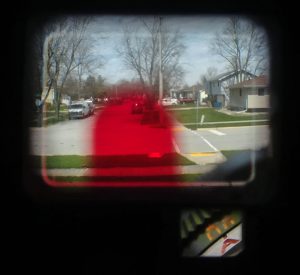
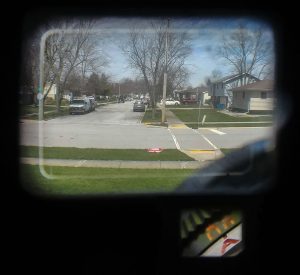
The viewfinder is large and bright, showing projected frame lines for the 40mm frame. The frame lines do not automatically correct for parallax, so there are hash marks to indicate the frame at close focus.
In an effort to make the camera as small as possible, the viewfinder is a bit too close to the lens which causes it to protrude into the viewfinder in the bottom right corner.
Below the viewfinder is a peep hole that allows you to read both the selected focus distance and shutter mode at the same time. In the previous two images, the camera is set to Portrait and Auto.
Lastly, when there is insufficient light to properly expose an image, a red flag will appear in the viewfinder window and the shutter release will be locked, preventing you from making an exposure. This could be a problem for people wanting to use faster film as the fastest speed supported is 400 but for most general shots it should be fine.
The Trip is very easy to use and I’ve found it’s best with cameras like these to not overthinking these, and to use them to their strengths, which is exactly how I intended to use it.
My Results
For my first roll through the Trip, I loaded in a fresh roll of Fuji 200 and took it with me to the Chicago Bears training camp prior to the 2019 season, and like the Bears season turned out to be, that first roll was a disaster as I foolishly used the camera without replacing the light seals and the entire roll had major light leaks in every single image. Whoops!
Into the repair queue went the camera, and after having a free weekend to replace the degraded light seals with some new ones, I loaded in another roll of Fuji 200 and took some fall pictures with it.
There is a reason the Olympus Trip 35 almost universally receives constant praise and was in production for over a decade and a half. This is an immensely fun and easy to use camera that delivers excellent results, and perhaps shocking to no one, my results were excellent too.
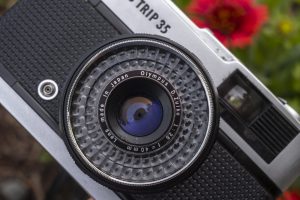
I left the camera in Auto mode for the entirely of it’s first two rolls and tried to use it as closely as possible to how it’s target audience would have. Looking at the images I got, they are all properly exposed, sharp across the frame, and show no signs of optical flaws common in lesser cameras. A tiny amount of vignetting was evident in a few images, but nothing that should bother anyone. As is the case with any lens marked Nikkor or Rokkor. Olympus’s lineup of Zuiko lenses make spectacular images.
The Olympus Trip wasn’t the first at anything except possibly being the first truly capable point and shoot camera and for that, has quickly become one of my favorite cameras in all of my collection. As much as I’d love to tell you that a folding plate camera from the 1920s or some quirky 1950s SLR is going to be my “go to” camera when I want to shoot film, the reality is cameras like the Olympus Trip will get the call far more often than 95% of what’s in my collection.
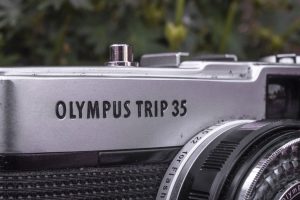
I could probably come up with a few nitpicks about the camera like for example the cramped viewfinder that is blocked by the lens in the bottom right corner, or being limited to only 2 shutter speeds and not having a true manual mode, but frankly, if Olympus had changed any of those things, it likely would have negatively affected the success of the camera. Having such a simple shutter meant that it was more reliable and cheaper to produce. Had the camera cost even as little as $10 more, less people would have bought it and it likely wouldn’t have been in production for as long. If there were more features it might have not appealed to the entry level consumer like it did.
The Olympus Trip 35 is a perfect example of “less is more” and in this case, it is WAY more. As this article tops 3400 words, I regret to say that I have nothing new to add to the countless number of positive articles about this camera that already exist.
They’re all right. This is a wonderful camera and one I strongly recommend you check out!
Related Posts You Might Enjoy
External Links
http://camera-wiki.org/wiki/Olympus_Trip_35
https://www.casualphotophile.com/2016/10/03/olympus-trip-35-camera-review/
https://kosmofoto.com/2017/03/olympus-trip-35-review/
https://www.kenrockwell.com/olympus/trip-35.htm
http://photo-utopia.blogspot.com/2008/03/olympus-trip-35.html
https://lewiscollard.com/cameras/olympus-trip-35/
https://schneidan.com/2016/07/01/olympus-trip-35/
https://wycameras.com/blogs/news/review-olympus-trip-35
http://mattsclassiccameras.com/rangefinders-compacts/olympus-trip-35/
https://www.kpraslowicz.com/2004/07/08/olympus-trip-35-1200th-modification


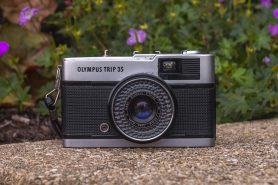
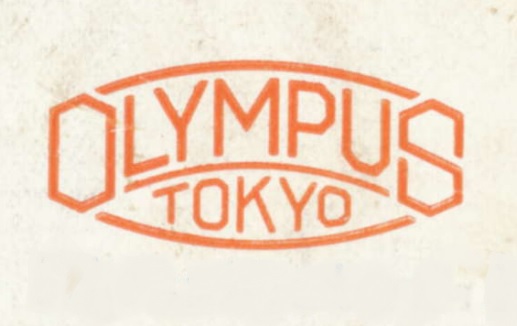















Now I understand why this camera is a consistent good seller on That Auction Site. For your readers who may not know, the letter preceding the name “Zuiko” on Olympus manual focus lenses indicates the number of elements, with A = 1, B = 2, etc etc through H = 8 (found on the H. Zuiko 35mm f2.0 in the OM series, which I think is the most complex prime lens Olympus made).
.
Early manual focus Nikkors of the pre-AI variety use a similar scheme, but the letters are based on Latin or mathematicians’ designations for the number of elements: T = tri, Q = quadra, P = penta, H = hexa, S = septa, on up thru D = deca.
Thanks for the feedback Roger, perhaps this would make for an article of it’s own as Minolta did it with their lenses too.
First Letter (no. of groups): T=3; Q=4; P=5; H=6; S=7; O=8; N=9.
Second Letter (no. of elements): C=3; D=4; E=5; F=6; G=7; H=8; I=9; J=10; K=11; L=12.
For example, the 58mm f/1.2 MC Rokkor – PG contained 7 elements in 5 group
I have 3 Trips and really must rationalise and sell a couple of them
String pull Kodak first successful point and shoot?
Thanks Mike and Roger for the Groups/Elements codes here. I knew Nikon, but not theothers
Great article! There was one change/variant you didn’t mention – the all black model produced for two years between 1968-1969. I have three Trips, one early Chrome button, one later black button and, of course, the Trip Noir, which is my faithful travel companion. I’ve even run some infrared film through it (successfully) – it truly is an exceptionally capable camera.
Mike I’ve had a few trips in my time and found them so easy and fun to use. There is a one thing to look out for when buying one, check the red flag pops up when you cover the meter with your hand indicating insufficient light – if it doesn’t show and the shutter still fires then you may have a problem. Also i thought the apature settings were mainly there for when a manual flash was attached and the user then sets the appropriate f stop for the subject to distance coverage needed.
Am I alone in thinking that the Trip 35 is the full frame version of the Pen EES2? I have both.
Olympus’s design theory back then shared a similar family resemblance across many models. I am certain that was intentional! 🙂
I found one of these with a working meter in a secondhand store in England for 50 quid! I was with my father in law and he was like “whaaat don’t buy that I can’t imagine it is worth that much, everybody used to have one of these!” Basically going on about how it was so simple etc. He is a great guy but I am glad I didn’t listen to him, it was the only camera I used for the rest of my England visit. Every shot was beautifully exposed and the focusing is so easy, I love this camera. Unfortunately last time I used it my entire roll turned out awful, not sure if it was the camera or a fault of the film (or myself) but have been nervous to shoot since.
Great story, Dakota! I am glad that you didn’t take your father in law’s advice and you bought the camera anyway. The reason everyone used to have an Olympus Trip is because of how easily it was to use and get great images from! As for your most recent roll, without knowing more of what happened, it is hard to tell if it was a fault of the camera or film.